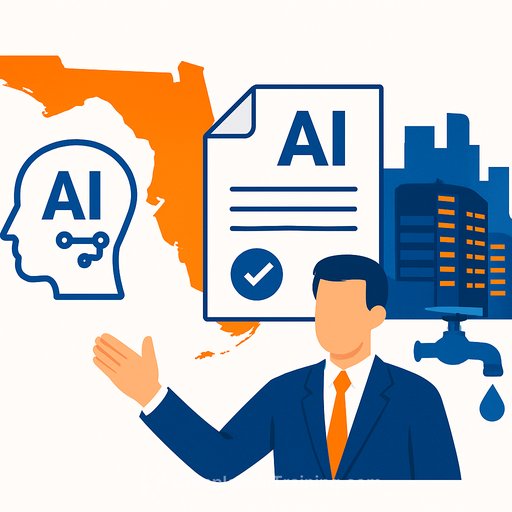Innovation Swarm Decision Intelligence: How AI Agent Teams Could Redefine Underwriting
Across carriers, underwriters have AI on the desktop yet still lean on spreadsheets, flood maps and inspection PDFs. Models assist, but they feel like better calculators, not decision partners.
The next leap won't come from a bigger model. It will come from coordinated teams of AI agents that specialize, debate, and converge on decisions in minutes-with underwriters in control.
What "swarm decision intelligence" means in underwriting
Think less single brain, more committee with rules. Each agent has a role: exposure analysis, pricing, fraud signals, legal/compliance, and appetite fit. They pull evidence, challenge each other's assumptions and present a ranked recommendation with reasons and uncertainties.
Underwriters stay in the loop. They can ask "why," run what-ifs, override, and set referral thresholds. The output isn't a score; it's a defensible decision package.
Why this matters for carriers
- Speed: Quotes move from days to minutes without cutting corners on diligence.
- Consistency: Agents follow the same playbook, every time, with full audit trails.
- Capacity: Underwriters spend more time on negotiation and edge cases, less on manual data wrangling.
- Loss ratio discipline: Every recommendation ties to exposure evidence and scenario tests.
A practical underwriting flow with agent teams
- Data intake agent: Ingest ACORDs, broker emails, schedules, inspections, geospatial, cat models, credit/business data and prior losses. Normalize, dedupe and flag gaps.
- Feature and quality agent: Validate addresses, valuations, COPE and time-in-business; estimate missing fields with uncertainty bands.
- Exposure/cat agent: Score flood, wildfire, wind, quake and secondary perils; run concentration checks and stress scenarios.
- Pricing/actuarial agent: Aligns to rating plans, calibration curves and corridor rules; produces ranges, not single points.
- Fraud/anomaly agent: Looks for mismatches across submissions, prior losses and external signals.
- Legal/compliance agent: Screens for regulatory constraints, sanctions, restricted classes and required endorsements.
- Debate/orchestrator: Forces agents to cite evidence, resolve conflicts and document trade-offs; escalates to human review when confidence or data quality falls below thresholds.
What the underwriter receives
- Recommended bind/decline/refer with confidence bands.
- Pricing range, terms and endorsements with rationales.
- Top risk drivers and what-ifs (e.g., "If roof year verified, price drops 3-5%").
- Traceable audit trail: data sources, checks performed, dissenting opinions and final tie-break logic.
Governance first, not last
Regulators expect oversight, fairness and documentation. Use a risk framework, document model and agent behavior, and keep evidence attached to the decision record.
- Adopt an AI risk framework such as the NIST AI RMF.
- Align with emerging insurance guidance like the NAIC bulletin on AI use by insurers.
Metrics that actually move the needle
- Time to first quote and time to bind.
- Hit ratio and average premium on appetite-aligned risks.
- Loss ratio by segment (pre/post), attach and endorsement accuracy.
- Referral rate, override rate and reasons.
- Regulatory/audit exceptions and rework.
Reference architecture (kept simple)
- Data fabric: Policy, claims, inspections, third-party APIs, geospatial and cat models behind a governed access layer.
- Retrieval layer: Search across documents and prior decisions with citations.
- Agent framework: Role-based agents with tool access, debate protocol and scoring rubric.
- Human-in-the-loop UI: Explainability, what-if controls, and referral workflows.
- Audit and risk controls: Versioned prompts/policies, test suites and decision logs.
Start small: a 90-day pilot plan
- Pick one line and scenario: e.g., cat-exposed homeowners new business, or mid-market property schedules.
- Define a decision contract: inputs, allowed tools, outputs, SLAs and referral rules.
- Stand up 5-7 agents max; keep roles crisp and measurable.
- Shadow mode for 4-6 weeks; compare to current process and calibrate.
- A/B test on a broker cohort; track speed, hit ratio and loss indicator proxies.
- Compliance sign-off and change management before scale-out.
Common pitfalls (and how to dodge them)
- Over-automation: Keep the human veto and clear referral triggers.
- Black-box risk: Require evidence citations and dissent logs for every decision.
- Model sprawl: Version agents and prompts like code; retire what you don't use.
- Data drift: Monitor source freshness, mapping errors and feature stability.
- Alert fatigue: Prioritize signals tied to loss ratio, not vanity metrics.
Use cases you can deploy now
- Cat homeowners: Agents cross-check roof condition, defensible space and flood elevation; price ranges adjust with verified evidence.
- Commercial property schedules: Split-by-region agents run COPE validation, valuation checks and concentration risk in parallel.
- Fleet and telematics: Behavior signals flow to pricing agent with explainable surcharges/credits and safety program suggestions.
What this changes for underwriting teams
You don't need to replace your core system or rating engine. You need a decision surface where experts-human and AI-can argue with data, document why a call was made and move faster with less variance.
The carriers that win will pair disciplined governance with agent teamwork, then scale the playbooks across lines and regions.
Next steps
- Pick a line and broker partner for a shadow pilot.
- Define a minimal agent roster and decision rubric.
- Measure speed, quality and explainability from day one.
- Upskill the team on prompt policies, debate protocols and audit-ready documentation. If you need structured learning paths, see AI courses by job role.
This isn't about flashy demos. It's about getting to better decisions, faster-and proving it with the numbers that matter.
Your membership also unlocks:






